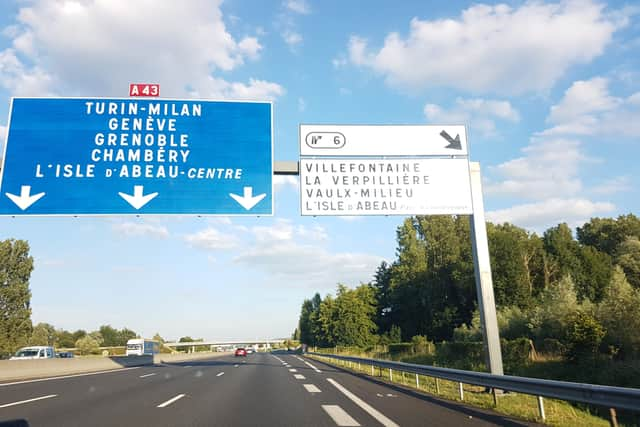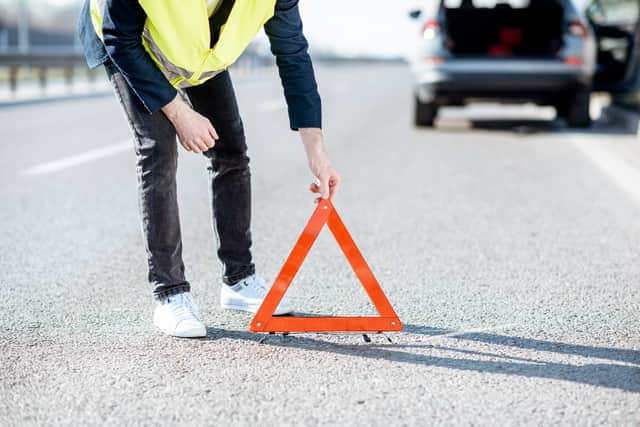Driving in Europe requirements 2023: post-Brexit laws - from UK sticker to green cards and driving permits
and live on Freeview channel 276
UK drivers remain worryingly in the dark on the rules for driving overseas, according to new research.
A study by eBay found that 40% were unaware of the requirement to display a UK sticker and more than a quarter didn't realise it was mandatory to carry a warning triangle in most of Europe. It also found a quarter wrongly believed it was compulsory to carry a disposable breathalyser when driving in France.
Advertisement
Hide AdAdvertisement
Hide AdWith more than 10 million UK drivers heading to the continent in their own cars every year, most of them in the summer months, the findings reveal major gaps in knowledge that could land motorists in trouble with the law.
After a period of post-Brexit uncertainty around insurance green cards, international driving permits and other paperwork, the rules around driving on the continent have been clarified and the good news is that the situation hasn’t changed massively. However, it’s still important to be clued up on the laws for driving in Europe.
Every country has its own local laws, including some occasionally surprising ones, but there are certain general guidelines to follow regardless of which country you are visiting.
Documents
Wherever you’re travelling in Europe you must carry your photocard driving licence with you, as well as your passport, copies of your car insurance documents and your vehicle’s V5C logbook.
Advertisement
Hide AdAdvertisement
Hide AdIt’s worth noting that although you can obtain your licence from the age of 17 in the UK, you must be 18 to drive in most European countries, including France, Spain, Germany and Italy.


After a brief period where they were compulsory, you no longer need a separate insurance green card for driving in the EU.
If you have a photocard licence issued in the UK you do not need an international driving permit (IDP) to drive in the EU, Switzerland, Norway, Iceland or Liechtenstein.
However, you might need an IDP if you only have a paper driving licence, a licence issued in Gibraltar, Guernsey, Jersey or the Isle of Man, or are staying for an extended period of time.
Advertisement
Hide AdAdvertisement
Hide AdYou can check which IDP you need via the Government website.
Essential equipment


Most European countries have a list of items that you must fit to/carry in your vehicle at all times. These include:
- UK sticker - Since September 2021 the old GB stickers are no longer valid and you need to display a UK sticker on your vehicle. The only exception to this is if your number plate already features a UK identifier and Union Flag.
- Headlamp beam adjuster - unless your vehicle’s lights can be adjusted from the vehicle
- Warning triangle
- High-visibility jackets
Some countries also require you to carry a first aid kit and spare bulbs, and in Spain anyone who wears glasses must carry a spare pair.
Speed limits and other laws
Speed limits vary between countries, so always check the specific rules for wherever you are visiting.
Advertisement
Hide AdAdvertisement
Hide AdIn general, motorway speed limits are between 110 and 130km/h and some countries reduce them in bad weather. Some sections of German autobahn are still unrestricted (marked by a black diagonal line on a white circle) but most have limits. On smaller single-carriageway roads 90km/h is common (80km/h in France) and expect limits of 50km/h in towns.
Radar jammers that warn of and interfere with speed traps are illegal across Europe and using one can lead to fines of up to €6,000. Even sat nav systems that warn of upcoming speed cameras are widely outlawed so it’s wise to disable the function if your car has it.
Drink-driving
The vast majority of European countries have a common drink-drive limit of 22 micrograms of alcohol for every 100 millilitres of breath (0.8g per litre of blood). This is lower than the limit in England, Wales and Northern Ireland and in line with the limit in Scotland. Some countries have a lower limit for novice drivers and some countries in central Europe and Scandinavian have limits of 0.2g/l or lower.
France has recently abolished the rule requiring drivers to carry breathalysers.
Travelling with children
Advertisement
Hide AdAdvertisement
Hide AdThe rules on when you must use car seats vary between countries but are broadly similar to those in the UK.
In France, any child under 10 must use a weight-appropriate car seat. In Spain, any child under the age of 12 or under 135cm needs to use one while in Germany any passenger younger than 12 or less than 150cm tall must use a car seat.
Fines
Traffic police across Europe have the power to issue on-the-spot fines to drivers, ranging from €35 in Germany to as much as €750 in France. They can, in the most extreme circumstances, even impound vehicles.
They now also have the power to pursue you at home. Since 2017, European police forces have been able to obtain keeper details via the DVLA and issue fines for offences committed abroad.
Low-emissions zones
Advertisement
Hide AdAdvertisement
Hide AdLike the UK, many European countries are introducing low-emissions zones in major cities to combat air pollution.


Some countries, such as France (Crit’air), Spain (ZEZ) and Germany (Umweltplakette) require vehicles entering these zones to display a sticker related to their emissions standards. Others, such as Belgium require drivers of foreign vehicles to register before entering the zones. In most cases, vehicles which do not meet certain standards are either banned entirely, at certain times or attract a charge for entering the LEZ.
Comment Guidelines
National World encourages reader discussion on our stories. User feedback, insights and back-and-forth exchanges add a rich layer of context to reporting. Please review our Community Guidelines before commenting.
